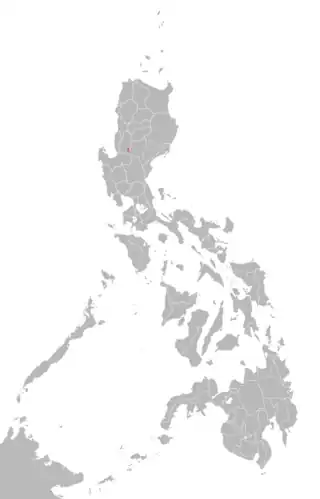| Iwaak | |
|---|---|
| I-wak | |
| Native to | Philippines |
| Region | Luzon |
Native speakers | 3,300 (2000)[1] |
Austronesian
| |
| Language codes | |
| ISO 639-3 | iwk |
| Glottolog | iwak1237 |
 Area where Iwaak is spoken according to Ethnologue | |
Iwaak (also spelled I-wak or I'wak) is a South-Central Cordilleran language spoken by almost 3,300 people around the Cordillera Central mountain range of Luzon, Philippines. It is a Pangasinic language which makes it closely related to Pangasinan, one of the regional languages in the country, with around 1.2 million speakers.
According to Ethnologue, in eastern Itogon municipality, Benguet Province, I-wak is spoken in Tojongan, Bakes, Lebeng, Domolpos, Bujasjas, and Kayo-ko villages. It is also spoken in Salaksak village, Kayapa municipality, Nueva Vizcaya Province.
References
- ↑ Iwaak at Ethnologue (18th ed., 2015) (subscription required)
| Official languages | |
|---|---|
| Regional languages | |
| Indigenous languages (by region) | |
| Immigrant languages | |
| Sign languages | |
| Historical languages | |
| Batanic (Bashiic) | |||||||||||||||||||||||||
|---|---|---|---|---|---|---|---|---|---|---|---|---|---|---|---|---|---|---|---|---|---|---|---|---|---|
| Northern Luzon |
| ||||||||||||||||||||||||
| Central Luzon |
| ||||||||||||||||||||||||
| Northern Mindoro | |||||||||||||||||||||||||
| Greater Central Philippine |
| ||||||||||||||||||||||||
| Kalamian | |||||||||||||||||||||||||
| Bilic | |||||||||||||||||||||||||
| Sangiric | |||||||||||||||||||||||||
| Minahasan | |||||||||||||||||||||||||
| Other branches |
| ||||||||||||||||||||||||
| Reconstructed | |||||||||||||||||||||||||
| |||||||||||||||||||||||||
This article is issued from Wikipedia. The text is licensed under Creative Commons - Attribution - Sharealike. Additional terms may apply for the media files.